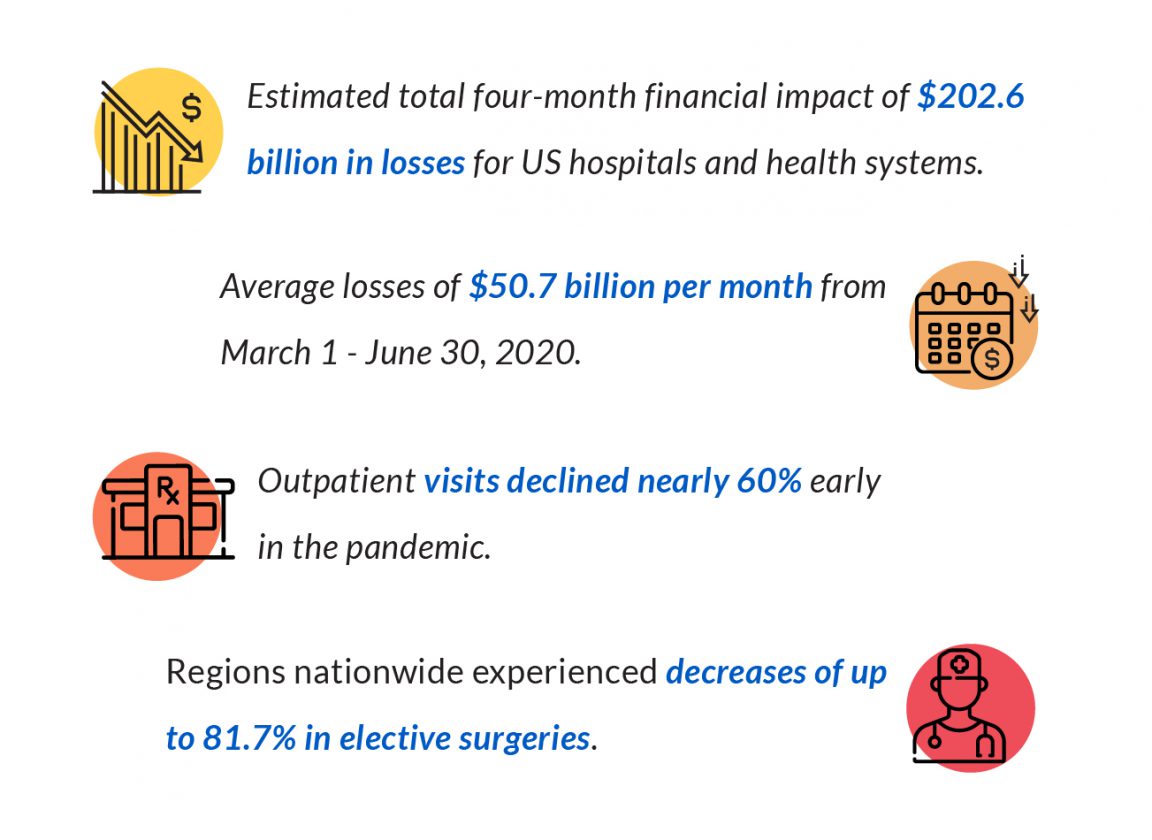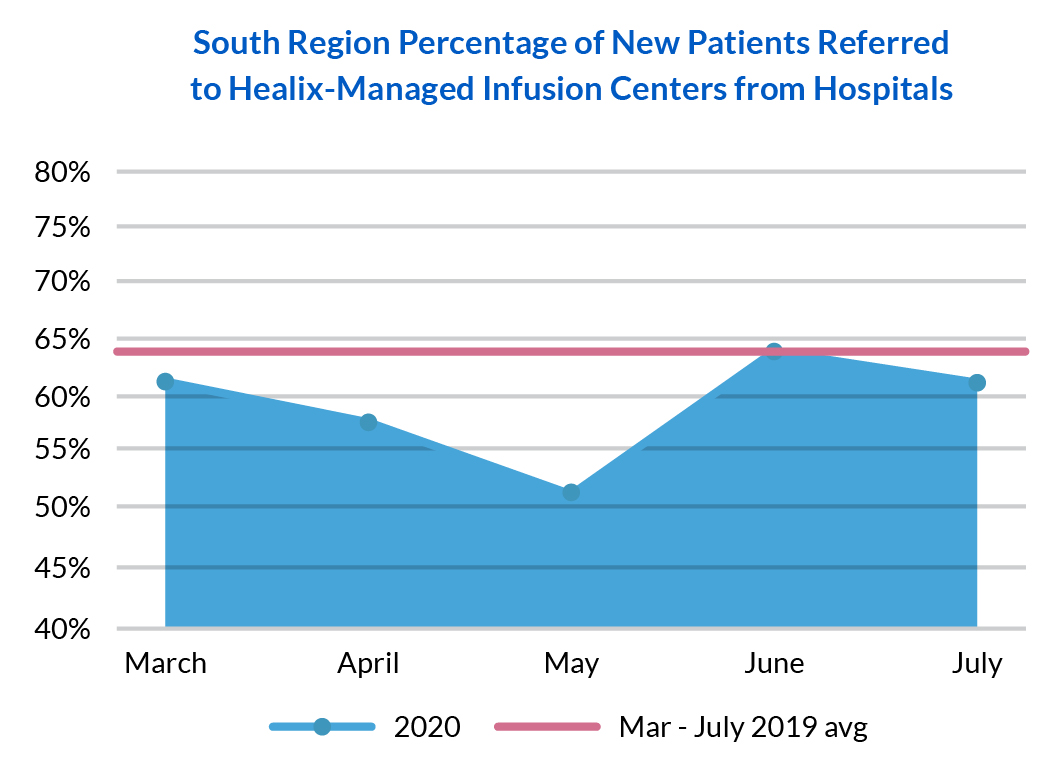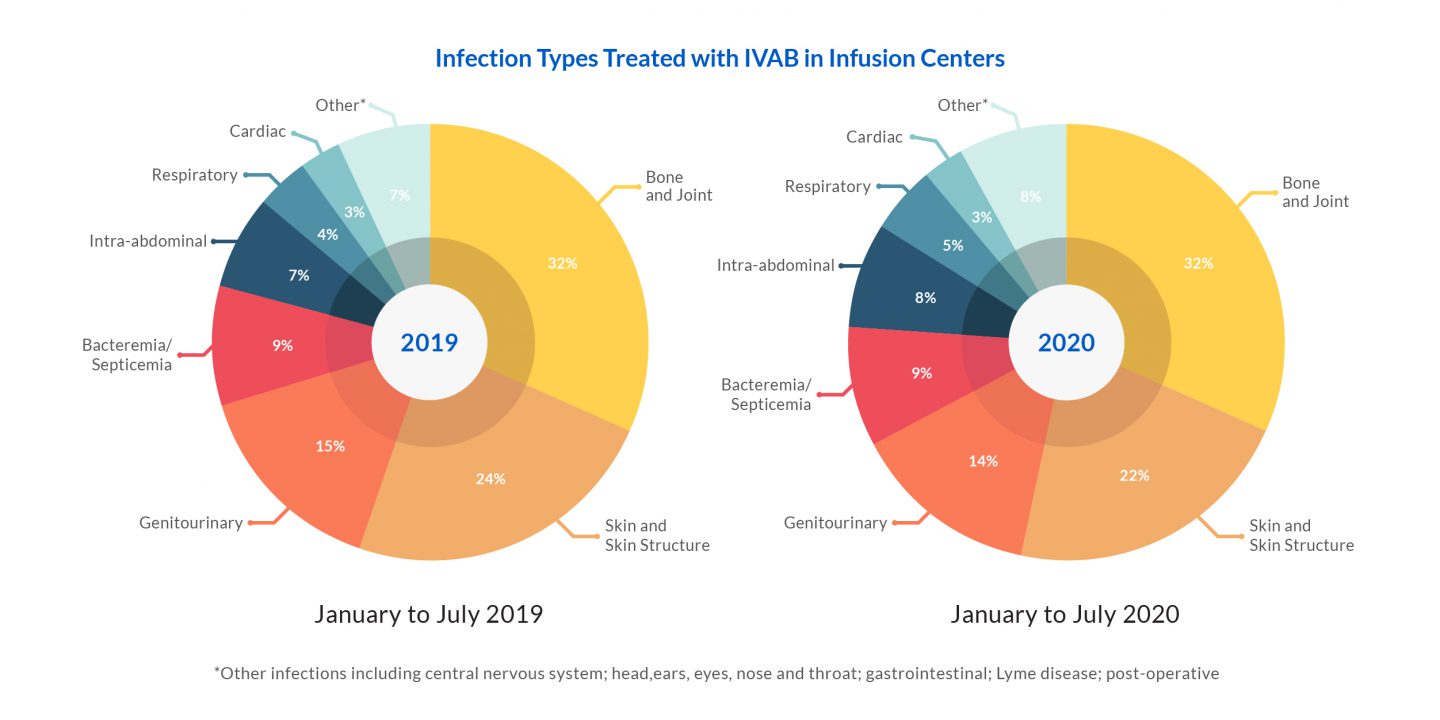COVID-19 Pandemic Initial Impact on Outpatient Intravenous Antibiotic Therapy

Introduction
The COVID-19 pandemic has dramatically affected the provision of healthcare services in the US. Routine and elective healthcare services experienced sharp declines due to COVID transmission fears, regional stay-at-home orders, and bans on many elective procedures.
Healix Infusion Therapy is an infusion management company focusing on the management of physician office-based infusion centers. We manage more than 350 infusion centers on behalf of physician practices, representing nearly 2,000 providers in the US. Of these, many are infectious disease physician practices with an in-office infusion center treating patients with serious infections in an outpatient setting.
Hospital and health system non-COVID patient volumes declined sharply as a result of the COVID-19 pandemic. The American Hospital Association (AHA) estimated a total four-month financial impact of $202.6 billion in losses for America’s hospitals and health systems, or an average of $50.7 billion per month from March 1, 2020 to June 30, 2020.1 Outpatient visits also declined nearly 60 percent early in the pandemic2,3 and regions nationwide experienced dramatic decreases of up to 81.7% in elective surgeries4 (as compared to prior years’ volume) during the same period.

The deferral of elective procedures resulted in fewer patients with severe infections requiring treatment with intravenous antibiotics (IVAB), which was observed through a decreased percentage of patient referrals following hospital discharge to Healix-managed infusion centers for continuation of IVAB therapy.
An analysis of the initial impact of the COVID-19 pandemic on the rate of hospital patient referrals for outpatient antimicrobial therapy during the height of regional stay-at-home orders and elective surgery cancellations
Typically, 60% of infections treated in Healix-managed infusion centers are continuations of antimicrobial therapy initiated in a hospital. We observed a decline in the proportion of patients referred for treatment with IVAB in these infusion centers following hospital discharge during the initial pandemic impact in March through May. This is not surprising given the elimination of routine and elective surgeries during the initial months of COVID-19. More typical referral rates were observed again in June and July 2020.

States issued stay-at-home orders and bans on elective procedures between mid-March through the beginning of April5. As a result, all US regions experienced a decline in elective surgeries from March to July, with the highest decrease in the Northeast region with 81.7%4 fewer surgeries compared to other years. Other US regions experienced decreases around 75%.
State orders went into effect in the Northeast region largely during the third week of March, and consequently Healix-managed infusion centers in that region6 experienced a decline in IVAB patient referrals by approximately 16% in April.

That decline was felt in the Northeast sooner than other regions like the South, which implemented orders primarily in the first week of April and saw the largest decline in patient referrals in late April and early May. The declines in both regions roughly corresponded with the timing of the procedure bans and stay-at-home orders in those regions. As Florida, Georgia, and Texas began to reopen and elective surgeries resumed, we saw an increase in new patient referrals. However, referrals again fell slightly in July when the COVID positivity rate in those states increased again.

Despite decreases in referrals for patients needing antimicrobial therapy, patient demographics and infection type remained the same
Across all patients treated with IVAB in Healix-managed infusion centers, the distribution of patient demographics and infection type remained proportional to 2019 even though overall referrals declines.

The leading infection type treated with IVAB in the infusion centers is bone and joint infection (BJI), a group of infections including osteomyelitis, prosthetic joint infections, and septic arthritis.7 This remained consistent from 2019 to 2020, with BJI consistently accounting for 32% of infection diagnoses treated with IVAB.

Conclusion
The COVID-19 pandemic has placed a considerable strain on the healthcare system. While inpatient facilities experienced sharp increases in emergency departments and intensive care units, other areas saw significant declines. Operating rooms were largely empty as elective procedures were halted. Correspondingly, many outpatient services and procedures also experienced declines. In Healix-managed infectious disease infusion centers, we also saw a decline in new patient referrals from inpatient facilities. Reduction in patient referral volumes began in March 2020, coinciding with the start of the pandemic, and continued through May 2020. In June and July 2020, activity and treatments began to rebound. As the healthcare system recovers from the lows experienced at the start of the pandemic, patient activity in the outpatient setting will likely continue to see volatility as regional COVID-19 outbreaks may affect elective procedures.
Despite declines in referral volumes, patient demographics and infection type remained consistent year-over-year. Bone and joint infections accounted for almost one-third of new patient referrals.
With a steadfast focus on providing patient and physician peace of mind for over 30 years, Healix remains committed to delivering safe and uninterrupted care for our infectious disease physicians and patients. Healix and its physician clients have participated in clinical trials for COVID-19 therapeutics and are preparing to support the administration of these therapeutics approved under Emergency Use Authorization. Details related to our experiences in research and treatment of COVID-19 disease will be outlined in a future release.
Download Full Report
Methodology
Researchers within Healix analyzed trends in new IVAB patients referred to Healix-managed physician office infusion centers between January to July in 2020, in comparison to the same period in 2019. Patients were counted as a “new patient referred” within the month’s total in which the referral was made. Any patients remaining on service in a subsequent month were not counted in that month’s “new patients referred” total. In some instances, as labeled, patients referred from the hospital setting were analyzed only during the months of heightened regional stay-at-home orders and bans on elective surgeries (March-July).
About Healix Infusion Therapy, LLC
Healix is the nation’s leader in providing physician office-based infusion services. Focused on patient and physician peace of mind for 30 years, we offer unparalleled capabilities for optimal patient care, comfort, compliance, and clinical outcomes in an outpatient setting.
References
1 American Hospital Association (2020). Hospitals and health systems face unprecedented financial pressures due to COVID-19. Published May 5, 2020. https://www.aha.org/system/files/media/file/2020/05/aha-covid19-financial-impact-0520-FINAL.pdf
2 Mehrotra A, Chernew M, Linetsky D, Hatch H, Cutler D. The impact of the COVID-19 pandemic on outpatient visits: practices are adapting to the new normal. Commonwealth Fund. Published June 25, 2020. https://www.commonwealthfund.org/publications/2020/jun/impact-covid-19-pandemic-outpatient-visits-practices-adapting-new-normal
3 Mehrotra A, Chernew M, Linetsky D, Hatch H, Cutler D. The impact of COVID-19 pandemic on outpatient visits: a rebound emerges. Commonwealth Fund. Published May 19, 2020. https://www.commonwealthfund.org/publications/2020/apr/impact-covid-19-outpatient-visits.
4 The Definitive Blog. When do Elective Surgeries Start at US Hospitals? Definitive Healthcare. Published May 27, 2020.https://blog.definitivehc.com/when-do-elective-surgeries-start-at-us-hospitals
5 Kaiser Family Foundation (KFF). When State Stay-at-Home Orders Due to Coronavirus Went into Effect. Published April 9, 2020. https://www.kff.org/other/slide/when-state-stay-at-home-orders-due-to-coronavirus-went-into-effect/
6 States considered in the Northeast region of the U.S. include Pennsylvania, New Jersey, New York, Connecticut, Rhode Island, Massachusetts, Vermont, New Hampshire, and Maine. States considered in the South region of the U.S. include Texas, Oklahoma, Louisiana, Arkansas, Mississippi, Alabama, Georgia, Florida, Tennessee, South Carolina, North Carolina, Kentucky, West Virginia, Virginia, Maryland, and Delaware.
7 Van Anglen L, Hardin TC, Schroeder CP. Infection incidence and utilization of antimicrobials in physician office infusion centers. Open Forum Infectious Diseases. 2017; 5 (Suppl 1): S704-S705.
